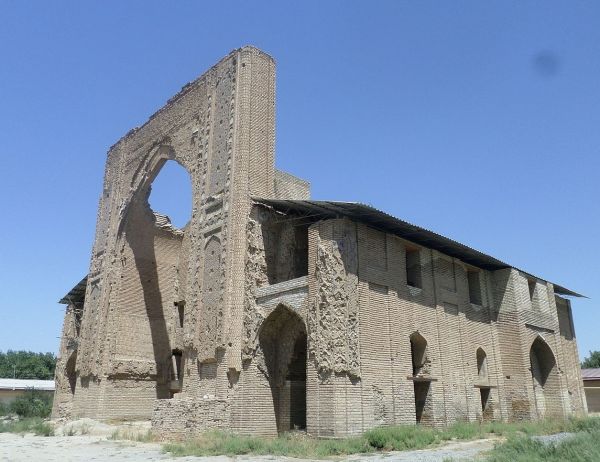Ishrathon Mausoleum
Almost all historical architectural monuments in Samarkand are associated with the era of the reign of the great Tamerlane. Ishrathona also belongs to them, but unlike other similar structures, it looks more ascetic. Although this building served as a place for merry feasts and a place for the burial of the Timurid family. Here, even Tamerlane himself was once threatened with death, according to ancient legends, but his grandson was able to save him.
The original idea of erecting Ishrathon in the XV century came to the ruler of Samarkand with the aim of creating a huge palace in which joy and fun will always reign. The name of Ishrathon literally translates as "house of fun" or "house of joy". By word of mouth, many generations of local residents have been passing on legends and legends about the origin of this legendary structure for several centuries.
One of the legends says the following. The conqueror Tamerlane took a horse ride around Samarkand. By the will of fate, he wandered into a wonderful garden, which turned his head with the scent of ripe peaches. In this peach orchard, Timur saw a young beauty and, on the spur of the moment, immediately made her a marriage proposal. The young girl immediately agreed to the powerful ruler, blushing a little from embarrassment. Such shared love led Tamerlane to indescribable joy and rejoicing. He immediately ordered the construction of a magnificent palace on the site of the peach orchard and gave it the name Ishrathon. Since then, the emir's merry and lavish feasts with his viziers, military leaders and nobles have been constantly held in this palace.
The following local legend tells about one such feast on an unprecedented scale. She is related to Timur's grandson, Ulugbek. The grandson of the great conqueror was more interested in education and sciences than in military affairs and campaigns. Tamerlane's heir had great knowledge of astronomy and somehow managed to calculate the day of his grandfather's death. It was on this day that the ruler of Samarkand held another feast in the building of the Ishrathon palace. Ulugbek saddled his horse and rushed to save his ancestor from certain death. Right on his horse, the heir burst into the palace building, chasing Timur and all his guests away. The enraged emir jumped to his feet and rushed at his grandson to teach him a lesson. It was at this moment that a powerful earthquake began and the vault of the palace collapsed on the very place where Tamerlane had been sitting just a minute ago. Naturally, Timur immediately relented and began thanking Ulugbek for his rescue. An interesting fact is that the emir did not rebuild the vault of Ishrathona in order to avoid a repeat collapse.
For unknown reasons, this palace was soon used as a tomb for many children and women from the great Timurid family. Ishrathona gradually fell into disrepair, and no one even tried to restore it. To this day, only a small fragment of the facade of this building has been preserved, but even this small part of it can be judged by the incredible beauty of the building.
The new destruction of the domes and arches of the former palace occurred during the earthquake of 1879. And in 1903, another series of aftershocks turned some of the galleries and domes of the building to dust. But natural disasters were not the only reason for the destruction of Ishrathon. Numerous looting also played a major role in this, especially after Samarkand joined the Russian Empire. Historians, painters and archaeologists began to come here in large numbers. They kept saying that the value of the relics of this ancient city was truly priceless, but no price could be paid to stop the looting. It is difficult to even roughly estimate the losses that have been incurred since that time.
Nowadays, one can only enjoy those remnants of the former splendor of Ishrathon. On the walls of the mausoleum, you can observe the numerous mosaics and drawings by ancient masters, which Tamerlane himself admired with his army. Of great interest are the facades of the tomb made of polished bricks, unusual tall windows with patterns and strong lattices, as well as the arched frames of the vaults, which give this "palace of joy and fun" the effect of weightlessness and absolute lightness.

























